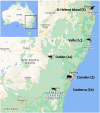Molecular detection and characterization of Coxiella burnetii in Australian native wildlife species
- PMID: 40577049
- PMCID: PMC12203902
- DOI: 10.1093/femsle/fnaf060
Molecular detection and characterization of Coxiella burnetii in Australian native wildlife species
Abstract
Q fever is a zoonotic disease caused by the bacterium Coxiella burnetii with domestic ruminants considered the main infection source for humans. Coxiella burnetii infection in Australian native wildlife (ANW) species has been demonstrated, however their role as reservoirs remains unclear. This study aimed to determine the prevalence of C. burnetii DNA in tissues, swabs, and secretions from ANW, (primarily marsupials from eastern Australia), and further understand the pathogenesis in these species by identifying tissues infected and potential shedding routes. The study utilized an optimized multiplex quantitative PCR assay targeting three C. burnetii genes and a stringent classification system that prioritized specificity to overcome false positives known to occur due to Coxiella-like endosymbiont species. Of the 141 animals examined, one eastern gray kangaroo cloacal swab tested positive for C. burnetii DNA (at ~11 genome equivalents per reaction) in all three genes. Four animals were classified as suspect with amplification in two genes at a lower copy number. Genotyping of the definitively positive animal returned a C. burnetii genotype previously associated with human Q fever cases, which underscores the importance of Q fever vaccination where available for individuals in contact with wildlife, given the potential severity of the disease in humans.
Keywords: Coxiella burnetii; Australia; Q fever; macropods, Australian native wildlife, multiplex qPCR.
© The Author(s) 2025. Published by Oxford University Press on behalf of FEMS.
Conflict of interest statement
The authors declare no conflict of interest.
Figures
Similar articles
-
Is the horse a reservoir or an indicator of Coxiella burnetii infection? Systematic review and biomolecular investigation.Vet Microbiol. 2013 Dec 27;167(3-4):662-9. doi: 10.1016/j.vetmic.2013.09.027. Epub 2013 Oct 1. Vet Microbiol. 2013. PMID: 24144862
-
High diversity of Coxiella burnetii genotypes in Q fever human cases from Spain, 2012-2024.Int J Infect Dis. 2025 Sep;158:107948. doi: 10.1016/j.ijid.2025.107948. Epub 2025 Jun 13. Int J Infect Dis. 2025. PMID: 40517836
-
Evidence of Coxiella burnetii and Bartonella species infections among patients with persistent febrile illness in four low- and middle-income countries.Clin Microbiol Infect. 2025 Aug;31(8):1389-1393. doi: 10.1016/j.cmi.2025.04.038. Epub 2025 May 6. Clin Microbiol Infect. 2025. PMID: 40339791
-
Coxiella burnetii in Minas and Coalho raw milk artisanal cheese and possible spatial associations with human exposure in Brazil: a cross-sectional study.Int J Food Microbiol. 2025 Nov 2;442:111386. doi: 10.1016/j.ijfoodmicro.2025.111386. Epub 2025 Aug 8. Int J Food Microbiol. 2025. PMID: 40829552
-
Coxiella burnetii infections from animals and ticks in South Africa: a systematic review.Vet Res Commun. 2024 Feb;48(1):19-28. doi: 10.1007/s11259-023-10204-z. Epub 2023 Aug 29. Vet Res Commun. 2024. PMID: 37642820 Free PMC article.
References
-
- Australian Technical Advisory Group on Immunisation . The Australian Immunisation Handbook. 2023. https://immunisationhandbook.health.gov.au/vaccine-preventable-diseases/...(4 March 2022, date last accessed).
MeSH terms
Substances
LinkOut - more resources
Full Text Sources


